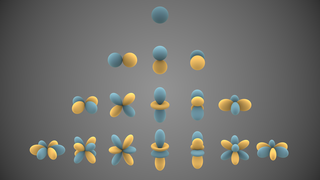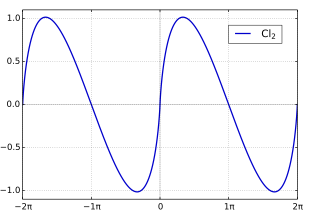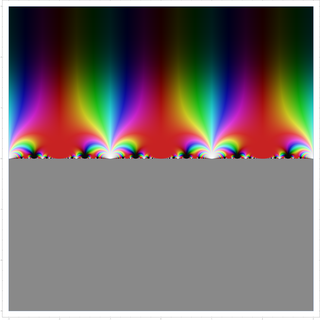




In complex analysis, a branch of mathematics, an amoeba is a set associated with a polynomial in one or more complex variables. Amoebas have applications in algebraic geometry, especially tropical geometry.





In complex analysis, a branch of mathematics, an amoeba is a set associated with a polynomial in one or more complex variables. Amoebas have applications in algebraic geometry, especially tropical geometry.
Consider the function
defined on the set of all n-tuples of non-zero complex numbers with values in the Euclidean space given by the formula
Here, log denotes the natural logarithm. If p(z) is a polynomial in complex variables, its amoeba is defined as the image of the set of zeros of p under Log, so
Amoebas were introduced in 1994 in a book by Gelfand, Kapranov, and Zelevinsky. [1]
A useful tool in studying amoebas is the Ronkin function. For p(z), a polynomial in n complex variables, one defines the Ronkin function
by the formula
where denotes Equivalently, is given by the integral
where
The Ronkin function is convex and affine on each connected component of the complement of the amoeba of . [3]
As an example, the Ronkin function of a monomial
with is

In mathematics, the winding number or winding index of a closed curve in the plane around a given point is an integer representing the total number of times that curve travels counterclockwise around the point, i.e., the curve's number of turns. For certain open plane curves, the number of turns may be non-integer. The winding number depends on the orientation of the curve, and it is negative if the curve travels around the point clockwise.
In statistics, maximum likelihood estimation (MLE) is a method of estimating the parameters of an assumed probability distribution, given some observed data. This is achieved by maximizing a likelihood function so that, under the assumed statistical model, the observed data is most probable. The point in the parameter space that maximizes the likelihood function is called the maximum likelihood estimate. The logic of maximum likelihood is both intuitive and flexible, and as such the method has become a dominant means of statistical inference.

In mathematics, the complex conjugate of a complex number is the number with an equal real part and an imaginary part equal in magnitude but opposite in sign. That is, if and are real numbers then the complex conjugate of is The complex conjugate of is often denoted as or .

In mathematics and physical science, spherical harmonics are special functions defined on the surface of a sphere. They are often employed in solving partial differential equations in many scientific fields.
In mathematics, in particular in algebraic topology, differential geometry and algebraic geometry, the Chern classes are characteristic classes associated with complex vector bundles. They have since become fundamental concepts in many branches of mathematics and physics, such as string theory, Chern–Simons theory, knot theory, Gromov–Witten invariants. Chern classes were introduced by Shiing-Shen Chern (1946).

In mathematics, the inverse trigonometric functions are the inverse functions of the trigonometric functions. Specifically, they are the inverses of the sine, cosine, tangent, cotangent, secant, and cosecant functions, and are used to obtain an angle from any of the angle's trigonometric ratios. Inverse trigonometric functions are widely used in engineering, navigation, physics, and geometry.

In mathematics, the Clausen function, introduced by Thomas Clausen (1832), is a transcendental, special function of a single variable. It can variously be expressed in the form of a definite integral, a trigonometric series, and various other forms. It is intimately connected with the polylogarithm, inverse tangent integral, polygamma function, Riemann zeta function, Dirichlet eta function, and Dirichlet beta function.
In mathematics, the Schwarzian derivative is an operator similar to the derivative which is invariant under Möbius transformations. Thus, it occurs in the theory of the complex projective line, and in particular, in the theory of modular forms and hypergeometric functions. It plays an important role in the theory of univalent functions, conformal mapping and Teichmüller spaces. It is named after the German mathematician Hermann Schwarz.
In mathematical statistics, the Fisher information is a way of measuring the amount of information that an observable random variable X carries about an unknown parameter θ of a distribution that models X. Formally, it is the variance of the score, or the expected value of the observed information.

In mathematics, tropical geometry is the study of polynomials and their geometric properties when addition is replaced with minimization and multiplication is replaced with ordinary addition:
In mathematics, the Mahler measureof a polynomial with complex coefficients is defined as
In mathematics, differential algebra is, broadly speaking, the area of mathematics consisting in the study of differential equations and differential operators as algebraic objects in view of deriving properties of differential equations and operators without computing the solutions, similarly as polynomial algebras are used for the study of algebraic varieties, which are solution sets of systems of polynomial equations. Weyl algebras and Lie algebras may be considered as belonging to differential algebra.
The Artin reciprocity law, which was established by Emil Artin in a series of papers, is a general theorem in number theory that forms a central part of global class field theory. The term "reciprocity law" refers to a long line of more concrete number theoretic statements which it generalized, from the quadratic reciprocity law and the reciprocity laws of Eisenstein and Kummer to Hilbert's product formula for the norm symbol. Artin's result provided a partial solution to Hilbert's ninth problem.
An external ray is a curve that runs from infinity toward a Julia or Mandelbrot set. Although this curve is only rarely a half-line (ray) it is called a ray because it is an image of a ray.

In mathematics, a complex logarithm is a generalization of the natural logarithm to nonzero complex numbers. The term refers to one of the following, which are strongly related:
In the mathematical field known as complex analysis, Jensen's formula, introduced by Johan Jensen (1899), relates the average magnitude of an analytic function on a circle with the number of its zeros inside the circle. It forms an important statement in the study of entire functions.
In mathematics, quaternionic analysis is the study of functions with quaternions as the domain and/or range. Such functions can be called functions of a quaternion variable just as functions of a real variable or a complex variable are called.

In mathematics, the modular lambda function λ(τ) is a highly symmetric Holomorphic function on the complex upper half-plane. It is invariant under the fractional linear action of the congruence group Γ(2), and generates the function field of the corresponding quotient, i.e., it is a Hauptmodul for the modular curve X(2). Over any point τ, its value can be described as a cross ratio of the branch points of a ramified double cover of the projective line by the elliptic curve , where the map is defined as the quotient by the [−1] involution.
A product distribution is a probability distribution constructed as the distribution of the product of random variables having two other known distributions. Given two statistically independent random variables X and Y, the distribution of the random variable Z that is formed as the product is a product distribution.
In mathematics the symmetrization methods are algorithms of transforming a set to a ball with equal volume and centered at the origin. B is called the symmetrized version of A, usually denoted . These algorithms show up in solving the classical isoperimetric inequality problem, which asks: Given all two-dimensional shapes of a given area, which of them has the minimal perimeter. The conjectured answer was the disk and Steiner in 1838 showed this to be true using the Steiner symmetrization method. From this many other isoperimetric problems sprung and other symmetrization algorithms. For example, Rayleigh's conjecture is that the first eigenvalue of the Dirichlet problem is minimized for the ball. Another problem is that the Newtonian capacity of a set A is minimized by and this was proved by Polya and G. Szego (1951) using circular symmetrization.